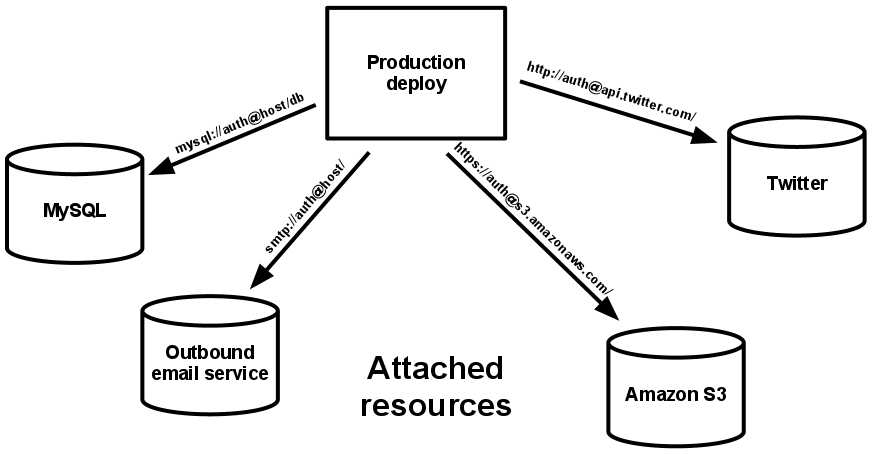简介
如今,软件通常会作为一种服务来交付,它们被称为网络应用程序,或软件即服务(SaaS)。12-Factor 为构建如下的 SaaS 应用提供了方法论:
- 使用标准化流程自动配置,从而使新的开发者花费最少的学习成本加入这个项目。
- 和操作系统之间尽可能的划清界限,在各个系统中提供最大的可移植性。
- 适合部署在现代的云计算平台,从而在服务器和系统管理方面节省资源。
- 将开发环境和生产环境的差异降至最低,并使用持续交付实施敏捷开发。
- 可以在工具、架构和开发流程不发生明显变化的前提下实现扩展。
这套理论适用于任意语言和后端服务(数据库、消息队列、缓存等)开发的应用程序。
背景
这套方法论由Heroku的联合创始人Adam Wiggins发掘,应用到了数以百计的应用程序的开发和部署,并通过 Heroku 平台间接见证了数十万应用程序的开发,运作以及扩展的过程。
The Twelve-Factor App系列文章,综合了Hero库关于 SaaS 应用几乎所有的经验和智慧,是开发此类应用的理想实践标准,并特别关注于应用程序如何保持良性成长,开发者之间如何进行有效的代码协作,以及如何 避免软件污染 。
英文原文
IV. Backing services
Treat backing services as attached resources
A backing service is any service the app consumes over the network as part of its normal operation. Examples include datastores (such as MySQL or CouchDB), messaging/queueing systems (such as RabbitMQ or Beanstalkd), SMTP services for outbound email (such as Postfix), and caching systems (such as Memcached).
Backing services like the database are traditionally managed by the same systems administrators who deploy the app’s runtime. In addition to these locally-managed services, the app may also have services provided and managed by third parties. Examples include SMTP services (such as Postmark), metrics-gathering services (such as New Relic or Loggly), binary asset services (such as Amazon S3), and even API-accessible consumer services (such as Twitter, Google Maps, or Last.fm).
The code for a twelve-factor app makes no distinction between local and third party services. To the app, both are attached resources, accessed via a URL or other locator/credentials stored in the config. A deploy of the twelve-factor app should be able to swap out a local MySQL database with one managed by a third party (such as Amazon RDS) without any changes to the app’s code. Likewise, a local SMTP server could be swapped with a third-party SMTP service (such as Postmark) without code changes. In both cases, only the resource handle in the config needs to change.
Each distinct backing service is a resource. For example, a MySQL database is a resource; two MySQL databases (used for sharding at the application layer) qualify as two distinct resources. The twelve-factor app treats these databases as attached resources, which indicates their loose coupling to the deploy they are attached to.
Resources can be attached to and detached from deploys at will. For example, if the app’s database is misbehaving due to a hardware issue, the app’s administrator might spin up a new database server restored from a recent backup. The current production database could be detached, and the new database attached – all without any code changes.
中文
IV. 后端服务
把后端服务(backing services)当作附加资源
后端服务是指程序运行所需要的通过网络调用的各种服务,如数据库(MySQL,CouchDB),消息/队列系统(RabbitMQ,Beanstalkd),SMTP 邮件发送服务(Postfix),以及缓存系统(Memcached)。
类似数据库的后端服务,通常由部署应用程序的系统管理员一起管理。除了本地服务之外,应用程序有可能使用了第三方发布和管理的服务。示例包括 SMTP(例如 Postmark),数据收集服务(例如 New Relic 或 Loggly),数据存储服务(如 Amazon S3),以及使用 API 访问的服务(例如 Twitter, Google Maps, Last.fm)。
12-Factor 应用不会区别对待本地或第三方服务。 对应用程序而言,两种都是附加资源,通过一个 url 或是其他存储在 配置 中的服务定位/服务证书来获取数据。12-Factor 应用的任意 部署 ,都应该可以在不进行任何代码改动的情况下,将本地 MySQL 数据库换成第三方服务(例如 Amazon RDS)。类似的,本地 SMTP 服务应该也可以和第三方 SMTP 服务(例如 Postmark )互换。上述 2 个例子中,仅需修改配置中的资源地址。
每个不同的后端服务是一份 资源 。例如,一个 MySQL 数据库是一个资源,两个 MySQL 数据库(用来数据分区)就被当作是 2 个不同的资源。12-Factor 应用将这些数据库都视作 附加资源 ,这些资源和它们附属的部署保持松耦合。
部署可以按需加载或卸载资源。例如,如果应用的数据库服务由于硬件问题出现异常,管理员可以从最近的备份中恢复一个数据库,卸载当前的数据库,然后加载新的数据库 – 整个过程都不需要修改代码。